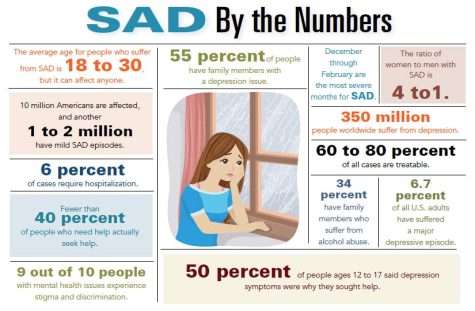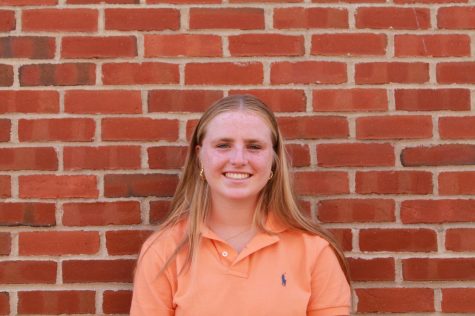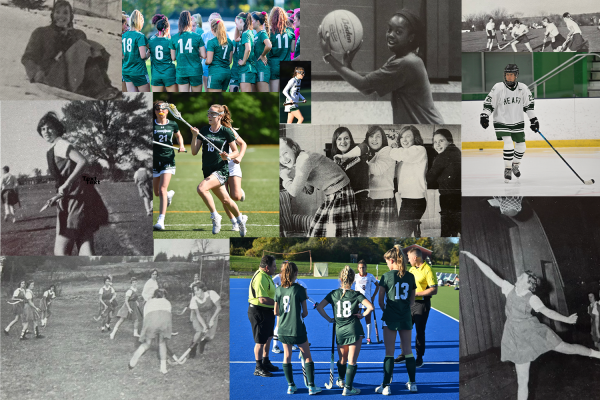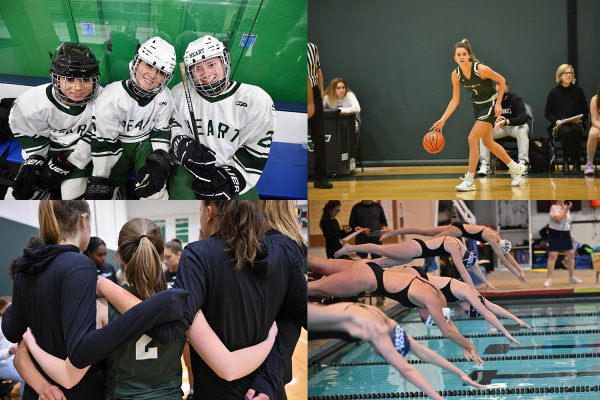The change of seasons bring about more than just change in weather
Students discuss how to combat the winter blues
Seasonal Affective Disorder (SAD) in fall and winter can cause adolescents to turn to social media as a distraction.
As fall ends and nature transforms into its winter stage, adolescents around the United States struggle with their mental health. Junior Ila David, co-head of the Behind Every Smile Club, shares how seasonal changes can affect teenagers’ moods, relationships, and motivation. She explains how the Sacred Heart Greenwich Behind Every Smile Club strives to support students suffering from Seasonal Affective Disorder (SAD) through presentations and activities.
Fall marks the beginning of school, sports, and extracurriculars. The return to these activities forms a daily routine that can become overwhelming for teenagers. To distract themselves from their routines, Ila mentions that teenagers seek entertainment and social media. However, this can often worsen their mood, causing teenagers to feel tired, sad, and sluggish, according to The New York Times. Ila comments on the role of social media in the development of SAD in teenagers.

“As the seasons begin to change, it becomes noticeable how much the weather has an effect on our mood,” Ila said. “The colder temperatures also keep us glued to our screens for escape, which eventually becomes very draining. For some individuals, it can feel like they are going through the same day over and over again because of the uneventfulness, sparking those feelings of seasonal depression.”
Social media can harm the mental health of adolescents because users present an unrealistic depiction of life. Ila warns that the fabricated reality people portray on social platforms can do more harm than good.
“Because adolescents tend to be on social media more in the winter, it’s easier to get presented with influencers that display perfect-looking lives, even though they tend to be extremely unrealistic and completely posed,” Ila said. “When we start to see that content more and more often, our brains sometimes convince us that these people we see have no problems. We begin to feel down on ourselves, and wish we had the lives of others, furthering into a depressive state.”
With the increase in cases of SAD as the winter months approach, Ila believes that it is important to understand how adolescents can combat fatigue and melancholy emotions. She highlights how people can adapt to these times and stresses the importance of working to make the best of the situation, rather than focusing on the negatives. Concentrating on the approaching holiday seasons, such as Halloween, Thanksgiving, and Christmas, can increase teenagers’ moods and create a sense of excitement. Ila shares specific activities that can boost serotonin levels in the brain.
“As the holidays begin to arrive, people find themselves focusing on certain activities that make them feel happy in order to enjoy the seasonal change. For example, drinking hot chocolate and watching holiday-themed movies, or preparing special meals,” Ila said. “It’s also about keeping connections with the ones who make you feel happy. Talking to friends, listening to music, or having a hobby are all great ways to lift up your mood.”
Ila hopes to raise awareness of SAD in the Sacred Heart community through the Behind Every Smile Club’s presentations. One of the club’s goals is to ensure that the school community learns about mental health issues. She believes that students and faculty can apply the knowledge they take from the club’s presentations and activities to their daily lives. Ila expresses the importance of spreading positivity throughout this season.

“We would like to have these conversations on topics like this one in smaller groups, that way, people can feel more comfortable starting a discussion and sharing their experiences versus directly hearing from one speaker in a large setting,” Ila said. “We also just want to spread love and joy through all the seasonal changes, making sure people know their resources and prioritize their mental health.”
Conversations about seasonal depression lead to awareness about how others feel or express these feelings in different settings. Ila voices that people can experience a positive change in feelings when someone notices how they are feeling or checks in. She indicates how even small gestures and plans to look forward to can brighten moods and mental states. Ila also considers that a school-wide support system and a sense of community can improve students’ mental health.
“Encourage yourself and others to try something new that can be an outlet for your feelings, whether that is through art, physical exercise, or another healthy activity,” Ila said. “As a community, it is super important to stay aware, connected, and continue to discuss this topic and mental health through seasonal changes.”
Featured Image by Zara Black ’23

Zara is looking forward to her second year of journalism for the King Street Chronicle as a section editor for Sports & Health. She is especially excited...












Catherine Butler • Oct 28, 2022 at 5:31 pm
Congratulations on your comprehensive and well-written article about SAD! It’s not only a timely topic, but one that can have a negative impact on our overall well being. Thank you for raising awareness on this issue.